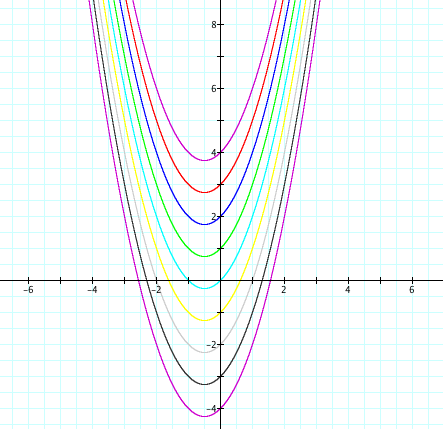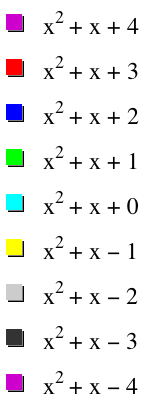

Shifty Parabolas
By: Russell Lawless
In this exploration we will be looking at the quadratic equation ax2 + bx + c. However the values of a and b will be fixed while c will vary. Below you can see that we made nine different graphs where c ranged from -4 to 4.



We see that it appears to move the graph of x2 + x in a vertical direction. When c is negative it is moving the graph down and when c is positive it is moving the graph up. However, what exactly is happening mathematically? First let's look at where -10 ≤ c ≤ 10.
To figure this out let’s focus on the quadratic equation, specifically the discriminant of the quadratic equation. The reason I chose to focus mainly on this principal is that when we are solving for the roots of a quadratic equation we use the quadratic formula. In the quadratic equation we focus on the discriminant because this is the only part of the quadratic equation that is affected by c. The equation for a discriminant is d = b2 - 4ac. The discriminate tells us how many solutions there are to an equation. If the discriminate is positive there will be 2 solutions, if it is negative then there will be no solutions, and if it is equal to zero then there will be one solution. So with the equations above listed from 1 to 9 we will show the discriminate for each solution.
1. -15 2. -11 3. -7 4. -3 5. 1 6. 5 7. 9 8. 13 9. 17
So equations 1 to 4 have no solutions while equations 5 to 9 have 2 solutions. The solutions for each of these can be found using the quadratic equation. That is ![]() . With this equation we will show the solutions for each equation.
. With this equation we will show the solutions for each equation.
1. ![]() 2.
2. ![]() 3.
3. ![]() 4.
4. ![]() 5.
5. ![]() 6.
6. ![]() 7.
7. ![]() 8.
8. ![]() 9.
9. ![]()
We see that the c value is changing the location of where our roots are.
Now the big question is can we prove that this is a translation and that the shape of the parabola does not change? If we prove that it is a translation, we are proving that it is isometric meaning that the distance is preserved. If the distance is preserved then we have proved that the shape of the parabola does not change. So we are going to focus on proving that it is a translation.
Since we are just focusing on the c parameter we will leave a and b out of the picture.
So we are going to try and prove this by focusing on the points of two different parabolas. Let A be any point that is on the parabola f(x). Let B be any point that is on the parabola g(x). So when we think of each point we see that A = (x, y) = (x, x2 + x + C) and B = (x, y) = (x, x2 + x + c). So now we use the formula for finding distances between two points in order to see if it is a translation. So the distance between A and B is found through the following mathematical procedures:

Therefore, since the distance between A and B ends up being a constant, we have shown that it is isometric and a translation.